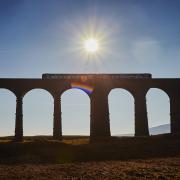English Heritage has ploughed £5 million into a radical transformation of Clifford’s Tower in York to create a huge new viewing space that allows visitors to linger for longer. It will open to visitors this Saturday(April 2).

The design cleverly preserves the ancient tower, but has created different levels within what was an empty shell - so visitors have more time and space to explore the building. The free-standing timber structure has been installed to have minimum impact on the fabric of the existing historic building.

Outside, new rails have been added alongside the steps to the tower with benches and resting places on the way.
Within the tower staircases and hanging walkways combine to take visitors ten metres up to the wooden roof deck from where they can enjoy the York skyline. There is an amphitheatre seating area and open viewing area so visitors can look down to the tower within.


‘One of England’s most important buildings, Clifford’s Tower is almost all that remains of York Castle, which was the centre of government for the North throughout the Middle Ages and up to the 17th-century - the place where the whole of the North of England was ruled from. We not only wanted to preserve this incredible building for generations to come, but also do justice to its fascinating and multi-faceted history.’
History
Clifford’s Tower crowns the mighty earthwork mound raised by William the Conqueror in 1068. For centuries it was the keep and chief strongpoint of York Castle, the greatest royal fortress in medieval northern England. At first, there was a timber tower here, where the most notorious event in the history of the castle took place in 1190, when the Jews of York, who had taken refuge in the tower, died in tragic circumstances. The stone tower was built soon afterwards and was used as a treasury and royal exchequer. In the 17th century, a fire destroyed the interior of the tower and the building was reduced to a shell. Many of the rest of the castle buildings were swept away when a new prison and court were built in the 18th and 19th centuries. As part of the construction of the County Gaol, the mound at Clifford’s Tower was cut back to make way for a new road and a large retaining wall was built around it. In 1935, the lower slopes of the mound were reconstructed.
www.english-heritage.org.uk/visit/places/cliffords-tower-york/




























